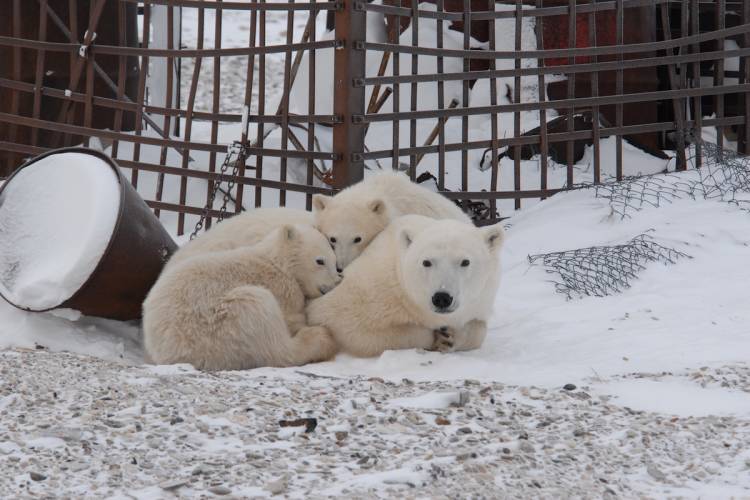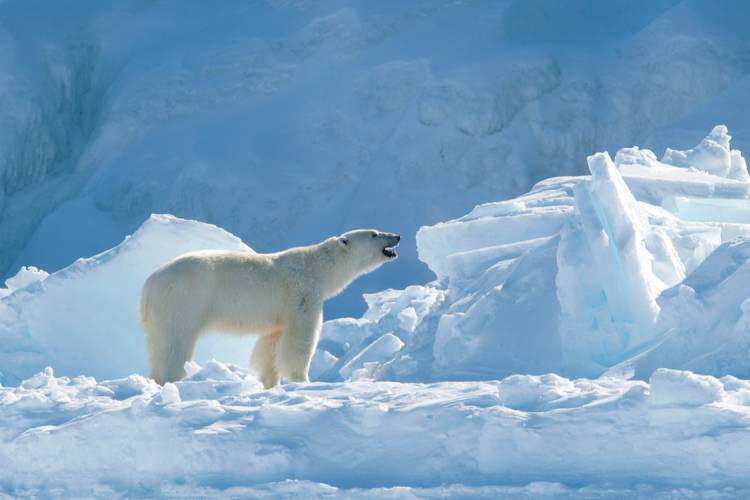How long have you been visiting and working there?
I started going to Ny-Ålesund in 2019. Until this year, I spent at most five or six months of the year there, but in stretches of a few weeks to months. At other times of the year, I worked with polar bears as a consulting scientist for Polar Bears International, and continue to do so today. When I was in Ny-Ålesund, I monitored seabird populations, spending two months in the field every day with just one other person.
You mentioned just now that Ny-Ålesund traditionally has not seen a lot of polar bears. Is this a situation where, now that some bears on Svalbard are staying ashore all year, that the community is starting to see more bears?
It seems like, since the end of overhunting in the 1970s, the local population of polar bears is recovering. But also, yes, there are possibly more visitations because the lack of sea ice, especially in the middle and later parts of the year, pushes bears closer to people. So it may be a combination of local bears establishing themselves and then sea ice conditions deteriorating, as a result of which bears are being forced ashore to look for alternative food sources.
Tell me about what prompted you to produce the brochure?
The brochure is just one part of a project to help the community prepare for increased visits from polar bears — and also to help visitors, who are arriving in increasing numbers, stay safe. So one goal was to have accessible, clear language to make sure that everybody arriving in Ny-Ålesund has access to free and extensive information on how to prepare themselves for the possibility of meeting a polar bear. The brochure helps people learn about polar bears, what they are like, where you’re most likely to meet them, how to avoid encounters, and what to do if an encounter happens.
It is an entry point, also guiding visitors further to the content I created for the Polar Bears International website, which provides more extensive information on avoiding and handling polar bear encounters. Another element is to undergo the training that is given by Kings Bay to all those arriving in Ny-Ålesund and wanting to obtain a rifle rental permit. One of the community’s massive challenges is that the population is extremely transient. The people who are there may be in town for just a few days or a few weeks. It's like starting with children and needing them to mature within an afternoon of training! You want them to have a mindset that allows them to work and/or recreate safely in this environment, but also adjust their behavior and plans to accommodate polar bears as well.
Are there other things the community does well with regard to polar bear interactions or that you would like to see it do better?
One thing that has been a great effort by the community is that there’s a Watchman crew in place – in fact, Polar Bears International honored the team’s efforts with its World Ranger Day Award in 2022. People who are working in different jobs in Ny-Ålesund — as carpenters, plumbers, electricians, airport operators, and so on — are part of the team, which responds to all kinds of situations that happen in town, from fires to a polar bear near the community.
What is great is that this team — through their transfer of experience and also their communication with each other — have established what to do when polar bears show up in different areas. There have been situations where a bear has been so close that the Watchmen chased it away with flares. But there also have been situations where bears were hunting on seal haulouts really near the town. Without disturbing the animals, the Watchmen observed polar bears for hours on end, on both sides of town, because there were two bears, hunting, and then napping, and then eating those seals.
A patrol like that is a very important step towards coexistence. However, I understand how costly it is in time and energy, and how economically costly it is when you have an increased number of bears in proximity. It means that a lot of people are watching the bears and not doing the work that they’re supposed to be doing to keep the station going.
Finally, I helped with a brief deterrence training in Ny-Ålesund on the use of hand-held flares provided by Polar Bears International as part of their coexistence efforts. Deterrents play an important role in staying safe in areas with polar bears, and now Ny-Ålesund includes them in their safety mix.


















